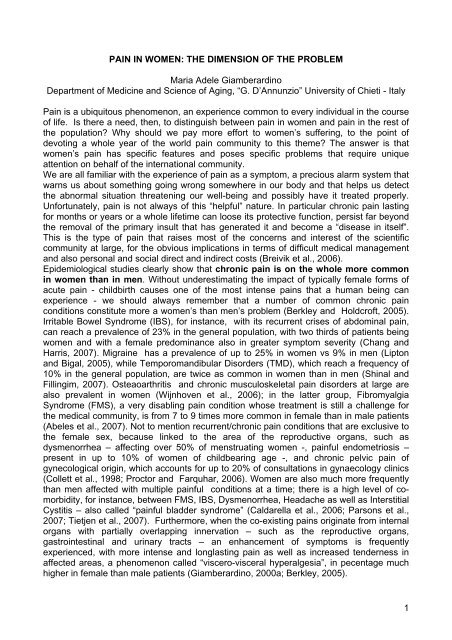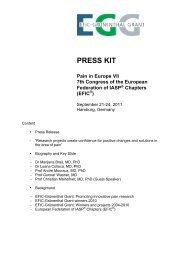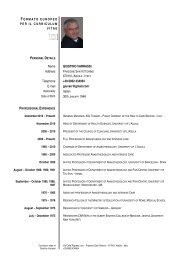Editorial - Prof. Dr. Maria Adele Giamberardino - EFIC
Editorial - Prof. Dr. Maria Adele Giamberardino - EFIC
Editorial - Prof. Dr. Maria Adele Giamberardino - EFIC
You also want an ePaper? Increase the reach of your titles
YUMPU automatically turns print PDFs into web optimized ePapers that Google loves.
PAIN IN WOMEN: THE DIMENSION OF THE PROBLEM<strong>Maria</strong> <strong>Adele</strong> <strong>Giamberardino</strong>Department of Medicine and Science of Aging, “G. D’Annunzio” University of Chieti - ItalyPain is a ubiquitous phenomenon, an experience common to every individual in the courseof life. Is there a need, then, to distinguish between pain in women and pain in the rest ofthe population? Why should we pay more effort to women’s suffering, to the point ofdevoting a whole year of the world pain community to this theme? The answer is thatwomen’s pain has specific features and poses specific problems that require uniqueattention on behalf of the international community.We are all familiar with the experience of pain as a symptom, a precious alarm system thatwarns us about something going wrong somewhere in our body and that helps us detectthe abnormal situation threatening our well-being and possibly have it treated properly.Unfortunately, pain is not always of this “helpful” nature. In particular chronic pain lastingfor months or years or a whole lifetime can loose its protective function, persist far beyondthe removal of the primary insult that has generated it and become a “disease in itself”.This is the type of pain that raises most of the concerns and interest of the scientificcommunity at large, for the obvious implications in terms of difficult medical managementand also personal and social direct and indirect costs (Breivik et al., 2006).Epidemiological studies clearly show that chronic pain is on the whole more commonin women than in men. Without underestimating the impact of typically female forms ofacute pain - childbirth causes one of the most intense pains that a human being canexperience - we should always remember that a number of common chronic painconditions constitute more a women’s than men’s problem (Berkley and Holdcroft, 2005).Irritable Bowel Syndrome (IBS), for instance, with its recurrent crises of abdominal pain,can reach a prevalence of 23% in the general population, with two thirds of patients beingwomen and with a female predominance also in greater symptom severity (Chang andHarris, 2007). Migraine has a prevalence of up to 25% in women vs 9% in men (Liptonand Bigal, 2005), while Temporomandibular Disorders (TMD), which reach a frequency of10% in the general population, are twice as common in women than in men (Shinal andFillingim, 2007). Osteaoarthritis and chronic musculoskeletal pain disorders at large arealso prevalent in women (Wijnhoven et al., 2006); in the latter group, FibromyalgiaSyndrome (FMS), a very disabling pain condition whose treatment is still a challenge forthe medical community, is from 7 to 9 times more common in female than in male patients(Abeles et al., 2007). Not to mention recurrent/chronic pain conditions that are exclusive tothe female sex, because linked to the area of the reproductive organs, such asdysmenorrhea – affecting over 50% of menstruating women -, painful endometriosis –present in up to 10% of women of childbearing age -, and chronic pelvic pain ofgynecological origin, which accounts for up to 20% of consultations in gynaecology clinics(Collett et al., 1998; Proctor and Farquhar, 2006). Women are also much more frequentlythan men affected with multiple painful conditions at a time; there is a high level of comorbidity,for instance, between FMS, IBS, Dysmenorrhea, Headache as well as InterstitialCystitis – also called “painful bladder syndrome” (Caldarella et al., 2006; Parsons et al.,2007; Tietjen et al., 2007). Furthermore, when the co-existing pains originate from internalorgans with partially overlapping innervation – such as the reproductive organs,gastrointestinal and urinary tracts – an enhancement of symptoms is frequentlyexperienced, with more intense and longlasting pain as well as increased tenderness inaffected areas, a phenomenon called “viscero-visceral hyperalgesia”, in pecentage muchhigher in female than male patients (<strong>Giamberardino</strong>, 2000a; Berkley, 2005).1
In addition to epidemiology, another important aspect is that women often report theirpain symptoms differently from men: awareness of these diversities is essential toavoid misdiagnosis. For example, chest pain from myocardial infarction tends to beatypical and more aspecific in women than in men (Lockyer, 2005; Albarran et al., 2007),with the atypical presentation resulting in delayed diagnosis, higher risk of complicationsand adverse prognosis (McSweeney et al., 2005; Jensen, 2007). As a general rule, painexpression in women is reported to be less predictive of a given disease than it is in men,with inevitable negative consequences on diagnosis and treatment. In contrast, pain inmen tends to manifest with a somewhat more clear-cut profile, which is much more easilytraced to a specific pathology (<strong>Giamberardino</strong> et al., 2000b).As compared to men, women also have higher sensitivity to pain stimuli and are subjectto fluctuations of their pain symptoms in relation to their hormonal status: premenopausal,post-menopausal, and during the different phases of the cycle in fertile years.Though the direction and extent of these fluctuations are reported to vary in the differentstudies, also depending on the type of pathologic pain entity considered, this hormonallinkedvariability is a unique feature to take into account when dealing with women’s pain(Hellstrom and Anderberg, 2003; Berkley, 2005: Aloisi and Bonifazi, 2006).A further issue is that the response to analgesic treatment is different in womencompared to men, which means that clinical trials devoted to test new drugs shouldspecifically take into account the gender diversity and plan a systematic differentiatedinvestigation in women and in men. Too often the results of trials conducted mostly in menare, instead, merely extrapolated to the women’s population, with deceiving results(Fillingim and Gear, 2004; Fillingim and Ness, 2004; Graven-Nielsen and Arendt-Nielsen,2007).Another important aspect is that the attitude of the Healthcare System and operators isoften “negative” towards women patients in pain. In many cases, female pain isunderestimated simply because it is regarded as “normal” or “physiological”, especiallythat originating from the reproductive area, since “if one is born a woman, one must put upwith pain” (Reddish, 2006). In other circumstances, the underestimation is motivated bythe conviction that mood disorders – anxiety/depression- are typical of the women andbring them to complain of pain more frequently than men, without plausible reasons. Againthe example of Fibromyalgia Syndrome is demonstrative. Since this pain condition is notassociated with any detectable organic alteration, but frequently co-exists with affectivedisturbance, and because it preferentially affects middle-aged women, it is often dismissedby physicians as “all in your mind”, a psychological problem of women in this phase of life.Not surprisingly, FMS was referred to, fortunately in the past, as “PsychogenicRheumatism” (Abeles et al., 2007).All these elements/diversities together can explain why women’s pain is too oftenunderestimated and less accurately diagnosed and treated than in men. Since socioculturalinfluences play a crucial role in a number of these diversities (Myers et al., 2003),the result is that the problem of pain in women is often dealt with differently indifferent nations.<strong>EFIC</strong> is particularly attentive to diversities in European countries, as it feels that awarenessof the national peculiarities is essential when trying to draw up common lines of politicalintervention in Europe aimed at increasing the well-being of women. It is with this purposethat <strong>EFIC</strong> has launched a campaign to collect information about the individual nationalstatus of women’s pain throughout Europe. All chapters have been invited to submitreports on the “state of the art” of pain in women in their country, e.g., the most prevalentpain conditions, level of public/private assistance, difficulties specifically encountered indiagnosis and treatment. The collection of these reports is underway and <strong>EFIC</strong> will publish2
the complete results in its website. We trust that this information will be of help to those incharge of raising awareness of the EU organizations responsible for healthcare andresearch funding in Europe.Last, but certainly not least, pain in women also needs more research; the reasonsunderlying differences in women’s vs men’s pain are multiple and complex: inaddition to the already mentioned socio-cultural influences, there are genetic, hormonal, aswell as psychological factors (Fillingim, 2000; Myers et al., 2003: Bernardes et al., 2007;Buskila, 2007). Clinical and basic science studies in each of these areas are furtherneeded to better understand the uniqueness of women’s pain and consequently to betterapproach its management. <strong>EFIC</strong> is devoting a grant to research in the field, in this year:the grant is dedicated to former President of <strong>EFIC</strong> <strong>Prof</strong>essor David Niv, who so attentivelylooked after the needs of people in chronic pain in Europe.The readers will find all details of <strong>EFIC</strong> initiatives in the website of the association.We trust that a whole year devoted to female pain by the international community willstrongly increase the degree of attention to this problem at all levels – individual,institutional, educational, political and scientific - an essential condition towards a betterunderstanding and management of women’s suffering.References- Abeles AM, Pillinger MH, Solitar BM, Abeles M, Narrative Review: The Pathophysiologyof Fibromyalgia, Ann Int Med, 146(2007)726-734.-Albarran JW, Clarke BA, Crawford J, 'It was not chest pain really, I can't explain it!' Anexploratory study on the nature of symptoms experienced by women during theirmyocardial infarction, J Clin Nurs, 16(2007)1292-1301.-Aloisi AM, Bonifazi M, Sex hormones, central nervous system and pain. Horm Behav,50(2006)1-7.-Berkley KJ, A life of pelvic pain, Physiol Behav, 86(2005)272-280.- Berkley KJ, Holdcroft A, Sex and gender differences in pain. In: SB McMahon, MKoltzenberg (Eds), Wall and Melzack's Textbook of Pain (5th ed.), Edinburgh, UK,Elsevier, 2005, pp 1181–1197.-Bernardes SF, Keogh E, Lima ML, Bridging the gap between pain and gender research: Aselective literature review, Eur J Pain, 2007 Oct 11 [Epub ahead of print].- Breivik H, Collett B, Ventafridda V, Cohen R, Gallacher D, Survey of chronic pain inEurope: prevalence, impact on daily life, and treatment, Eur J Pain, 10(2006)287-333.- Buskila D, Genetics of chronic pain states, Best Pract Res Clin Rheumatol, 21(2007)535-547.3
- Caldarella MP, <strong>Giamberardino</strong> MA, Sacco F, Affaitati G, Milano A, Lerza R, Balatsinou C,Laterza F, Pierdomenico SD, Cuccurullo F, Sensitivity disturbances in patients withirritable bowel syndrome and fibromyalgia, Am J Gastroenterol, 101(2006)2782-2789.- Chang L, Harris L, Irritable Bowel Syndrome and Functional Abdominal Pain Syndromes:Clinical Features and Management. In: PJ Pasricha, WD Willis, GF Gebhart (Eds), ChronicAbdominal and Visceral Pain, Informa Healthcare, New York, London, 2007, pp 357-372.- Collett BJ, Cordle CJ, Stewart CR, Jagger C, A comparative study of women with chronicpelvic pain, chronic nonpelvic pain and those with no history of pain attending generalpractitioners, Br J Obstet Gynaecol, 105(1998)87-92.-Fillingim RB, Sex, gender, and pain: women and men really are different, Curr Rev Pain,4(2000)24-30.- Fillingim RB, Gear RW, Sex differences in opioid analgesia: clinical and experimentalfindings, Eur J Pain, 8(2004)413-425.-Fillingim RB, Ness TJ, Sex-related hormonal influences on pain and analgesic responses,Neurosci Biobehav Rev, 24(2000)485-501.- <strong>Giamberardino</strong> MA, Visceral Hyperalgesia. In: M Devor, MC Rowbotham, Z Wiesenfeld-Hallin (Eds), Proc. 9 th World Congress on Pain, Progr Pain Res Man, Vol. 16, IASP Press,Seattle, 2000a, pp 523-550.- <strong>Giamberardino</strong> MA, Sex-Related and Hormonal Modulation of Visceral Pain. In: RBFillingim (Ed), Sex, Gender, and Pain, Progr Pain Res Man, Vol 17, IASP Press, Seattle,2000b, pp 135-163.- Graven-Nielsen T, Arendt-Nielsen L, Gender differences in response to pain, UgeskrLaeger, 169(2007)2425-2427.- Hellstrom B, Anderberg UM, Pain perception across the menstrual cycle phases inwomen with chronic pain, Percept Mot Skills, 96(2003)201-211.- Jensen J, Gender differences in ischemic heart disease, Ugeskr Laeger, 169(2007)2435-2437.- Lipton RB, ME Bigal, Migraine: Epidemiology, Impact, and Risk Factors for ProgressionHeadache, J Head and Face Pain, 45 (2005)3–13.-Lockyer L, Women's interpretation of their coronary heart disease symptoms, Eur JCardiovasc Nurs, 4(2005)29-35.-McSweeney JC, Lefler LL, Crowder BF, What's wrong with me? Women's coronary heartdisease diagnostic experiences, Prog Cardiovasc Nurs, 20(2005)48-57.-Myers CD, Riley JL 3rd, Robinson ME, Psychosocial contributions to sex-correlateddifferences in pain, Clin J Pain, 19(2003)225-232.4
- Parsons JK, Kurth K, Sant GR, Epidemiologic issues in interstitial cystitis, Urology,69(2007)5-8.- Proctor M, Farquhar C, Diagnosis and management of dysmenorrhoea, BMJ,332(2006)1134-1138.- Reddish S, Dysmenorrhea, Aus Fam Physic, 35(2006)842-849.- Shinal RM, Fillingim RB, Overview of orofacial pain: epidemiology and gender differencesin orofacial pain, Dent Clin North Am, 51(2007)1-18, v.- Tietjen GE, Herial NA, Hardgrove J, Utley C, White L, Migraine comorbidityconstellations, Headache, 47(2007)857-865.- Wijnhoven HA, de Vet HC, Picavet HS, Prevalence of musculoskeletal disorders issystematically higher in women than in men, Clin J Pain, 22(2006)717-724.5






